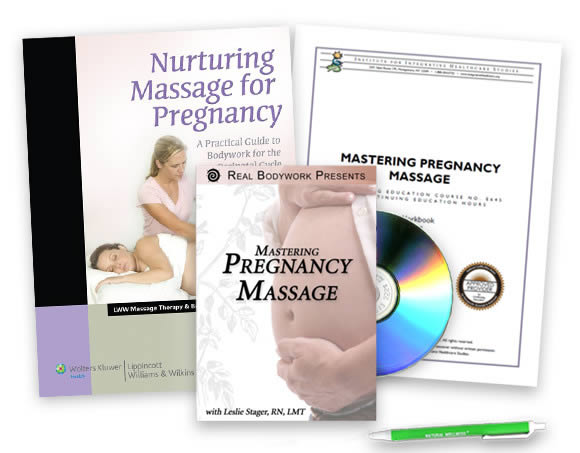Materials
- Video - Approximately 3 hours
- Text - 255 pages
- Multiple-choice test
- Certificate upon completion
Description
Explore the unique needs of the pregnant client while learning about the stages of growth and what to expect in each trimester of pregnancy. Leslie Stager, RN, LMT guides you through text and video focusing on general soft-tissue and Swedish massage while also integrating some myofascial release and trigger point techniques for your pregnant and laboring clients. In addition to the clear charts and illustrations included throughout the course text, the in-depth course video demonstrates proper draping and the techniques in a coherent flow.
To address the concerns of many massage practitioners with regard to working with pregnant clients, contraindications and precautions are examined thoroughly, along with a review of basic obstetrical practices and conditions that a massage therapist might encounter if working with women throughout a pregnancy and birth. The course dispels common myths anbout the dangers of particular bodywork, such as massage or reflexology to the ankles, and highlights the areas where practioners need to use caution.
Through the study of these course materials you will:
- Outline basic embryonic and fetal development.
- Describe maternal physiological and emotional changes that take place during each trimester of pregnancy, including the impact of hormonal changes and physiological changes to the organs.
- Discuss the impact that weight gain, hormone changes, self-esteem and pre-pregnancy muscle tone have on posture and the postural and muscular stresses and adaptations that occur during pregnancy.
- Conduct posture assessment, learning how to adjust posture to relieve strain.
- Explain signs of uterine ligament strain.
- Recognize when there is separation of the rectus muscle and learn how to prevent and address a separation.
- Identify safety concerns and precautions for each trimester, along with high-risk obstetric conditions, and know when to refer pregnant client to a physician based on symptoms that may indicate health problems.
- Develop a comprehensive intake for prenatal clients which includes health intake and medical release forms that address concerns for massage therapists.
- Recognize appropriate positioning for prenatal clients for each trimester and show proper draping and methods for supporting the client’s changing body.
- List 10 common complaints of pregnant women and their causes.
- Understand massage techniques and facilitated stretching for addressing common prenatal complaints.
- State the benefits, concerns and contraindications of breast massage during pregnancy.
- Ascertain massage techniques that facilitate physical relaxation in preparation for labor.
- Explain the physiological and emotional benefits of touch for pregnant woman and the impact stress can have on labor.
- State an explanation of Gate Control Theory of pain and how it applies to touch during birth.
- Differentiate between the different stages of labor and identify which techniques are appropriate for each stage.
- List topics that should be discussed with clients before birth.
- Recognize 5 different positions that may be used during labor to make the woman more comfortable.
- State 6 complaints and conditions of labor that can be addressed by massage therapy; including slowed or stalled labor and "back labor".
- Explain physiological and structural changes that occur during postpartum and discuss the benefits of massage therapy for these conditions.
- Recognize the contraindications and precautions for the postpartum period.
- Demonstrate assessment of spine, posture, abdominals and psoas during postpartum period.
- Give reasons for 10 common postpartum complaints and identify massage techniques for each.
- Examine postpartum breast massage techniques.
- Specify 11 reasons why a cesarean section may be done and identify benefits and precautions for massage when working on clients who have had a C-section.
This course shares essential knowledge and practical skills that a massage therapist needs to provide safe, competent, and nurturing bodywork to women during one of the most emotionally and physiologically challenging times of their lives. Observing the appropriate precautions, practitioners can feel confident that their work will never harm a pregnant, laboring or post partum client or her baby.
Course Objectives
- Observe the unique aspects of working with pregnant, laboring and postpartum women and the benefits of touch during the childbearing cycle as well as the multiple levels on which touch during pregnancy impacts a woman and baby.
- Discuss various worldviews of massage during pregnancy and postpartum.
- Outline basic embryonic and fetal development.
- Describe maternal physiological and emotional changes that take place during each trimester of pregnancy, including the impact of hormonal changes and physiological changes to the organs.
- Discuss the impact that weight gain, hormone changes, self-esteem and pre-pregnancy muscle tone have on posture and the postural and muscular stresses and adaptations that occur during pregnancy.
- Conduct posture assessment, learning how to adjust posture to relieve strain.
- Explain signs of uterine ligament strain.
- Recognize when there is separation of the rectus muscle and learn how to prevent and address a separation.
- Identify safety concerns and precautions for each trimester, along with high-risk obstetric conditions, and know when to refer pregnant client to a physician based on symptoms that may indicate health problems.
- Develop a comprehensive intake for prenatal clients which includes health intake and medical release forms that address concerns for massage therapists.
- Locate acupressure points that are contraindicated during pregnancy.
- Recognize appropriate positioning for prenatal clients for each trimester and show proper draping and methods for supporting the client’s changing body.
- List 10 common complaints of pregnant women and their causes.
- Understand massage techniques and facilitated stretching for addressing common prenatal complaints.
- State the benefits, concerns and contraindications of breast massage during pregnancy.
- Ascertain massage techniques that facilitate physical relaxation in preparation for labor.
- Explain the physiological and emotional benefits of touch for pregnant woman and the impact stress can have on labor.
- State an explanation of Gate Control Theory of pain and how it applies to touch during birth.
- Differentiate between the different stages of labor and identify which techniques are appropriate for each stage.
- List topics that should be discussed with clients before birth.
- Recognize 5 different positions that may be used during labor to make the woman more comfortable.
- State 6 complaints and conditions of labor that can be addressed by massage therapy; including slowed or stalled labor and "back labor".
- Explain physiological and structural changes that occur during postpartum and discuss the benefits of massage therapy for these conditions.
- Recognize the contraindications and precautions for the postpartum period.
- Demonstrate assessment of spine, posture, abdominals and psoas during postpartum period.
- Give reasons for 10 common postpartum complaints and identify massage techniques for each.
- Examine postpartum breast massage techniques.
- Specify 11 reasons why a cesarean section may be done and identify benefits and precautions for massage when working on clients who have had a C-section.
Course Reviews
Kara De Caneo
12/3/2024
I don’t think the video is needed in relation to the questions asked.
Shelly Scott
11/23/2024
The order of the test questions did not fall in line with the normal reading of the book and I found myself flipping back and forth too much. It became quite frustrating. This was a first for me, as all other tests I've taken follow the book throughout.
Megan Blevins, LMT
10/31/2024
Karisa Marcelletti, LMT
10/11/2024
Karen Lee Gale, LMT, BCTMB
10/9/2024
Read more reviews
Instructors

Leslie DeMatteo, MS, LMT
Leslie L. DeMatteo, LMT, MS, has been an active massage therapist since 1998, after graduating from the Sarasota School of Massage Therapy in Sarasota, FL. There she completed the massage therapy program along with a certificate program in Nuad-Bo-Rarn: Traditional Massage of Thailand.
Since then, she has completed continuing education in cranial-sacral fundamentals, cancer and mastectomy massage, reflexology, trigger point therapy and prenatal massage. She is also certified by the National Certification Board for Therapeutic Massage and Bodywork (NCBTMB) and is a Professional Level member of Associated Bodywork and Massage Professionals (ABMP).
Her work in massage therapy continuing education and teaching in a massage school ignited a passion for adult training and education, which led her to pursue her Bachelor's Degree in Adult Learning: Vocational Instruction, followed by her a Master's Degree in Adult Learning.
Ms. DeMatteo is the instructor for many of the Institute's courses including such courses as Advanced Prenatal Massage, Ethics of Diversity. Cupping Therapy: A Step-by-Step Approach, Diversity: Cultural Competence, Mastering Pregnancy Massage, and many more.
Back to Top



